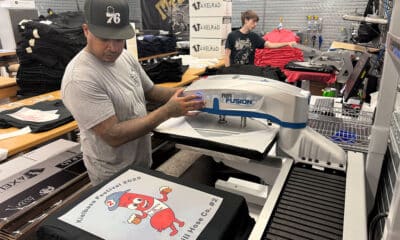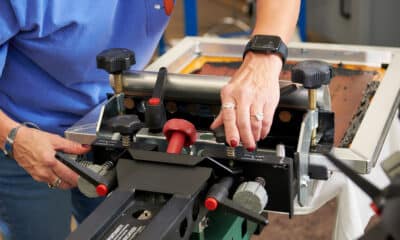WHETHER WE CHOOSE to accept it or not, rush orders are at the absolute epicenter of our industry. During my 10 years as a production manager, for the sake of my sanity, I’ve had no choice but to find a way to make peace with rush orders. But, before I go into detail about the results of that journey, I would like to preface by saying that I understand the concept of a “rush order” is an elusive and expansive one that can be hard to define.
Does the customer have an unforeseen circumstance or an event where they need shirts made tomorrow? While that does happen on occasion, it’s much more likely that it came as the result of some vague communication breakdown or an unopened email. I’ve lost years off my life from stress as the result of someone else’s unanswered email.
Sadly, we won’t be resolving the human condition today but be ready for rushes (regardless of how they inevitably happen). Then address them within the parameters of the decorated apparel industry because that’s important to both your business and your sanity.
To put it in the most over simplified terms, there is no avoiding rush orders. But the upside to facing them head on and learning to embrace them as truth tellers can help improve your general workflow. They provide the tough love that your business needs to reveal the truth about your team, your processes, and where those stand in the bigger picture. They are the only honest metric of production performance in our industry.
Nearly anyone can make a print look good if you have two days to set it up. But can you do it today when you weren’t even expecting it? Sadly, in our industry, it’s not even a question of whether if don’t want to or if you want to. If you’re aiming for any type of long-term success with your business, you have to.
In my personal experience from talking with owners and managers from all over the U.S., many shops go wrong with thinking that maybe one day they won’t have to do rush orders. Or they view them as a means to an end they are enduring. I’m here to regretfully inform you, it doesn’t end. Nor should it.
So, even before we get into the production techniques for processing these orders, it starts with a philosophy shift. Rush orders are necessary for the survival of your business and reside at the very nature of what you do. It is important to keep in mind that the way we perform as a business under stressful circumstances tells us who we really are. Rush orders help point out the parts of our internal processes that are weak and need to be fixed. Dare I say: Embrace the rush order!

Seasoned, longer-run screen printers may not fathom expanding their services to include rush orders. The concept is an elusive and expansive one that can be hard to define but is necessary to understand to flourish in today’s competitive arena
1. Philosophy: Expect the Unexpected
The first step in overcoming the burden of rush orders is to start with a philosophical shift. Instead of thinking of these orders as an inconvenient exception, shift into thinking of them as the main part of what you do. And the “normal” turnaround orders are gifts from the screen-printing gods.
Make rush orders the rule and not the exception. I know it sounds crazy, and it will make a lot more sense as we get into the next steps, but what is the alternative option? Be stress riddled every day?
As I mentioned earlier, after a decade of doing rushes thinking one day they would go away in favor of all great clients who have their act together, I realized I was philosophically setting myself up for failure. Doing the best work we can as quickly as we can is what we do. The solution to the never-ending stress and variables of our industry isn’t to try and avoid it or conquer it but to work through it and with it. This understanding is the foundation of every subsequent step. With all of that out of the way, let’s get into the more practical aspects of successfully processing rush orders.
Philosophy Quick Tip: In this industry, rushes aren’t something we have to do, they are what we do. Embrace it.
2: Scheduling
Make a habit of cutting empty space in your daily schedule for rush orders, even if there aren’t any. Don’t get me wrong, presses should constantly be running and you also don’t want your press operator to feel the “empty space.” What I mean when I say empty space is the need for double booking an allotted amount of time — with both a potential rush order and an order that is ahead of schedule. This way, if a rush job doesn’t come through then you’re working ahead.
The important lesson is not to just accommodate what you have. Any job is going to seem like a rush to a printer who thought they only had to do the four jobs that they had that morning. So rather than scheduling a press for a whole day, schedule it in two-hour clips. This gets the operator used to working in smaller increments so if a rush does need to come through later in the day, they don’t even perceive it as a rush. I always say, “Rushes are for managers, not for printers.”
For example: If you block a press out for an entire day, regardless of whether you assign it five orders or seven orders, both workloads will somehow magically still take eight hours. In other words, if you make the operator’s span of expectation the full day, it’s likely that the operator will adjust to accommodate that pace right at the beginning of their shift.
So, introducing a “rush” order into that is bound to create tension regardless of whether they “should” be able to get it done with the allotted time. But if you schedule and block out in two-hour increments, even a rush doesn’t feel like a rush. It’s just what’s next. It allows you the freedom to accommodate rushes and allows the printer to be free from the frustrations of changing expectations.
Scheduling Quick Tip: Consistent and dynamic press scheduling keeps your options open for fitting in daily rushes.
Advertisement

Rack up the rush orders! They are necessary for the survival of your business and reside at the very nature of what you do.
3. Pre-Production
Since most aspects of the screen-printing production process run in sequential order, it can be easy to overlook the aspects of pre-production that can happen simultaneously. Staging blanks, preparing inks, and burning screens can and should all happen at the same exact time rather than an order moving from one department to the next.
This should be happening for all jobs, but specifically for rush orders, it brings your pre-production down from hours to minutes. When a rush is triggered on your centralized schedule, all three aspects of pre-production can happen quickly and at the same time.
Pre-Production Quick Tip: Pre-production departments should be working simultaneously and not in sequence.
4: Production
When it comes to producing rushes at the presses, the harsh truth is that your presses already should be running as efficiently and consistently as they can on a regular basis. With that in mind, I strongly emphasize that the last place you want to speed up the rush job is at the press. It’s the place where quality needs the utmost consideration. It isn’t lost on me how counterintuitive that sounds. But theoretically speaking, your presses should always be operating at a high capacity that doesn’t have much room for “rushing.”
With that said, the best advantage to use for physically producing work faster is to spread the workload out from the start. Assuming you have the luxury of having multiple machines, use one press to do the front location while another simultaneously does the back. It also isn’t lost on me that this seems obvious, but by building it into your regular daily workflow, your team can see it and they become used to doing it.
This way when a genuine rush job does come in, there’s a sense of camaraderie in getting it done and that the burden is shared. It’s important to do this on a regular basis with non-rush jobs as well, just to build the overall ethic of shared responsibility on your production floor. And then when the time is needed to speed things up, you already have that gear available to shift into.
Production Quick Tip: Spread the shared workload out amongst two or more operators.

The best advantage to use for physically producing rush work faster is to spread the workload out from the start. Here, Axelrad staffer Sam Boedeker is preparing screens for production.
5: Post-Production: Mandatory Check List
Often the most overlooked — and least discussed aspect of a rush order — is post-production. There’s a sense that once a job goes into the dryer it’s “done” and that often proves to be a detrimental oversight. A poorly quality-checked and packed job is the quickest way to lose a customer, regardless of how fast it was done. The internal struggles we go through to get something out the door fast makes it seem justified in just getting it in the box.
But most rushes aren’t the fault of the customer. They have no reason to be forgiving or appreciative of the miracle you just pulled. It’s still gotta’ look good when that box gets opened.
Post-Production Quick Tip: Have a mandatory post-production protocol checklist. It’s very easy to skip over protocols in stressful times, so having to physically mark a checklist will ensure that each team member is still liable for each step.
Advertisement


 Expert Perspectives2 months ago
Expert Perspectives2 months ago
 Women in Screen Printing1 month ago
Women in Screen Printing1 month ago
 Shop Management2 months ago
Shop Management2 months ago
 Case Studies3 weeks ago
Case Studies3 weeks ago
 Women in Screen Printing1 month ago
Women in Screen Printing1 month ago
 Kevin Baumgart2 months ago
Kevin Baumgart2 months ago
 Thomas Trimingham4 weeks ago
Thomas Trimingham4 weeks ago
 Marshall Atkinson1 month ago
Marshall Atkinson1 month ago

















